|
Wartime Charminster 1939-45
Evacuation Zone
Considered a relatively safe area, almost as soon
as war broke out in 1939, Bournemouth received busloads of children
evacuated from Southampton. The first to arrive and be put up
in the Winton area were pupils from St Anne's Girls Secondary
School who were 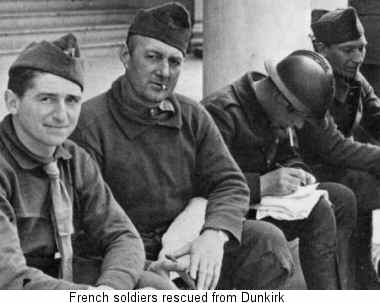 accommodated
at Talbot Heath. Next came pupils from Taunton's Secondary School
who were to share the newly opened Bournemouth School for Boys. accommodated
at Talbot Heath. Next came pupils from Taunton's Secondary School
who were to share the newly opened Bournemouth School for Boys.
Taunton's was the largest school in England to be
evacuated, and among the children was future comedian Benny Hill.
He always spoke of the kindness shown locally to the evacuees.
Over the coming months, many of the children returned to their
home town.
The next wave of evacuees came in early June 1940
as the German army swept across France. Over a period of several
days, the area suddenly found itself host to hundreds of French
soldiers who had been ferried across the channel to avoid surrender
at Dunkirk. The first to arrive in Bournemouth were billeted at
Malmesbury Park and Alma Road Schools. Many were invited to share
meals and hospitality with local families.
There were queues for baths at Stokewood Road. The
Frenchmen were showered with gifts and barbers even gave them
free shaves and haircuts. By June 12 they had all been moved to
camps elsewhere and life returned to normal.
Between 19 and 26 June the same operation was repeated
- this time it was mostly British soldiers who had been fighting
a rearguard action to protect the Dunkirk evacuation. They had
been shipped across the channel from Dieppe and Cherbourg.
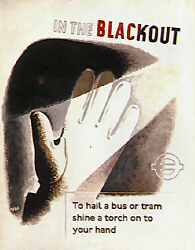 The
Blackout The
Blackout
The blackout was introduced in July 1939. The idea
was to make towns invisible to enemy aircraft at night time, but
it had a side effect of causing road accidents in the darkness.
Street lights were switched off, headlamps were
masked and all widows were sealed at night with lightproof material.
Traffic lights were switched off across Bournemouth.
They were left on at only seven locations. One of them was Winton
Banks, and another was Cemetery Junction. The blackout was not
relaxed until the autumn of 1944. The majority of street lamps
were still gas.
Air Raid Precautions (ARP)
ARP wardens were familiar figures with a number
of responsibilities including issuing gas masks, checking that
lights were covered during the blackout and dealing the the effects
of bombing. Garages, sheds, shops and other buildings served as
ARP warden posts. The Fiveways Hotel Garage was one of them
Air Raid Sirens
The authorities expected to get 22 minutes warning
of approaching enemy aircraft. Within ten minutes the alarms would
sound an alert and ten minutes later wardens would be on patrol
(or taking cover at their posts). When the danger was over, an
"all-clear" would be sounded. The sirens audible in
Winton were on the roofs of the Fire Station, Bournemouth School
for Boys and at an ARP post in Richmond Park Crescent. At the
start of the war the sirens were operated manually, but by the
summer of 1940 they had been converted to remote control through
the telephone lines. Tests were carried out on the first Monday
of every month at 2 in the afternoon.
Raids
|

Wreckage of the Alma Road School
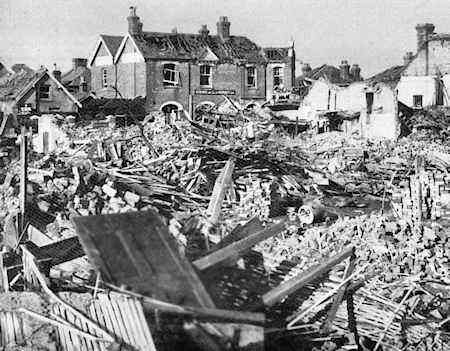
A battered Brunswick amid the
debris of Malmesbury Park Road
on 16 November 1940
|
Bournemouth had its share of bombing during the
Second World War. More than fifty air raids left 219 people dead
and 726 injured. Two thousand two hundred and seventy bombs rained
down on the town, destroying around 250 buildings. Another 13,590
needed repairs.
The area's worst raid was at 3.30 in the early hours
of the morning of November 16, 1940. A member of the Home Guard
on duty at Moordown bus depot claimed in the moonlight to have
opened fire on an aircraft with Italian markings. Records suggest
this was a purely German attack - there were no Italian units
in flying distance. The enemy aircraft dropped flares, incendiary
bombs and parachute mines.
Parachute landmines landed on the Alma Road, St
Leonards Road and Malmesbury Park Road areas. More than 50 people
were killed and around 150 injured in the raid which also hit
other parts of the town, including the house that had once belonged
to Robert Lewis Stevenson. Sixteen properties were destroyed around
St Leonards and Malmesbury Park Roads.
Alma Road School was destroyed by a direct hit and
a number of houses were flattened in and around Kings Road. Pupils
from the Alma Road infants and junior classes shared lessons at
Malmesbury Park School while the Alma Road Senior girls shared
classes with the Porchester Road senior boys.
The Fitzharris Avenue Methodist Church had its windows
blown out and the weather cock on top of the Winton Banks Plaza
cinema was never the same again.
Services and Sunday School for the Methodist congregation
were provided at the St Lukes Church Hall until the chapel had
been repaired. Local people made homeless in the raid were offered
help at the Winton YMCA in Jamieson Road.
Here's a summary of the rest of the raids that Charminster
and Queens Park suffered:
- October 21, 1940, 4.39PM. Ten bombs dropped by a tip and run
raider. Ten people injured and 212 properties damaged. Numbers
24 and 26 Shaftesbury Road were destroyed, other houses in Avon
Road and Queens Park Gardens were damaged.
- March 15 1941. 2.05AM. One bomb damages 19 properties in Gerald,
Grafton and Iddesleigh Roads . Three people suffer minor injuries.
Two others land in the cemetery and damage an ARP warden's post.
- March 27 1941. 12.20PM. Three people injured and 101 properties
damaged as bombs hit Lowther and Methuen Roads. Houses in Alma
Road are evacuated because of unexploded bombs.
- May 10 1941. 0.45AM. Incendiary bombs fall on Fernside Road,
Strathmore Road and The Avenue, Moordown. No damage.
- August 12 1943. 1.10AM. Thirteen people killed and more than
1400 buildings damaged as bombs fall on various parts of Bournemouth
including Shelbourne Road, Charminster Avenue and Strouden Avenue.
- November 1 1943. 5.45PM. One person killed, 27 injured and
1284 (final estimate) buildings damaged as a pair of Ju88 aircraft
dropped around 25 bombs on Heron Court, Gerald, Howard, Avon,
Chatsworth, Bennet, Orchestron, Shaftesbury and Shelbourne Roads
and Queens Park and Cecil Avenues. Bombs also blew craters in
the Queens Park golf links. In Avon Road the Laundry and Haydens
Engineering Works were temporarily closed because of unexploded
bombs in the street. Two of the houses hit in Queens Park Avenue,
89 and 111, were being used by the army. A French Canadian Major
was killed in no 89. Number 135 Queens Park Avenue was also
wrecked - the family survived only because they were in their
Morrision shelter.
- April 24 1944. 2.17AM. Two people died, seven were injured
and 156 properties were damaged in the area's last air raid
of the war. There were incendiary and/or unexploded bombs in
Charminster Avenue and Stour, Avon, Strouden, Beatty, Portland,
Gresham, Shelbourne, Sutton, Malvern and Holdenhurst Roads.
Here is the initial official ARP report of the raid on November
1, 1943
|
Air
Raid - Bournemouth November 1st, 1943.
An air raid warning was received at 17.20
hours, bombs were dropped at 17.45 hours. White received
18.29 hours.
Believed two planes J.U.88 came in over Purbeck
Hills, and flew over town and out South to sea.
Bombs were dropped at the following points:-
| Junctions of Heron Court & Gerald
Roads |
1 H.E |
500kg |
| Cemetery |
1 H.E |
500kg |
| Cecil Avenue |
1 H.E |
50kg |
| Howard Road |
1 H.E |
50kg |
| Queens Park Avenue |
3 H.E |
50kg |
| Campbell Road |
1 H.E |
500kg |
| Borthwick Road |
1 H.E |
500kg |
| Queens Park Golf Links |
4 H.E |
50kg |
| |
|
|
| Avon Road |
4 U.X.B |
50kg |
| Bennett Road |
2 U.X.B |
50kg |
| Chatsworth Road |
1 U.X.B |
50kg |
| Orchestron Road |
1 U.X.B |
50kg |
| Shaftesbury Road |
1 U.X.B |
50kg |
| Shelbourne Road |
1 U.X.B |
50kg |
| Allotment St George's Avenue |
1 U.X.B |
50kg |
Damage all in residential areas. One Laundry,
and Haydens Engineering Works out of action for 24 hours
owing to U.X.B.
Only one gas main was fractured in Gerald
Road. Owing to heavy rain there was a shortage of tarpaulins,
further supplies were obtained from Dorset.
6 Rest Centres were opened soon after the
raid. 112 people slept in Rest Centres during the night.
They were all billeted the following morning. By 1800 hours
November 2nd the first 8 U.X.B.s that had been discovered
were cleared, and people evacuated were able to return to
their homes. On the 3rd November a further U.X.B. was discovered
which was cleared the same day, and on the 5th November
another one was discovered which was also cleared the same
day.
The morning following the raid the Public
Information Service at the Town Hall and Billeting Officers
were available.
All Incidents were closed the same evening
as raid, except the areas with U.X.B.s.
No mutual assistance was required. Public
Morale was unaffected.
Morrison Table Shelters were the means of
saving a number of people from serious injury.
The casualties were as follows:-
|
Killed
|
Seriously Injured
|
Slightly Injured
|
|
M
|
F
|
C
|
M
|
F
|
C
|
M
|
F
|
C
|
|
1
|
-
|
-
|
3
|
6
|
1
|
9
|
8
|
-
|
Housing Damage:-
|
Demolition
|
Necessary for demolition
|
Repairable
|
Slight damage
|
|
-
|
8
|
24
|
691
|
Post Warden T. Dunn deserves special mention,
in that, although his home was badly damaged he carried
on with his duties and was an inspiration to all Wardens
at the Post.
|
For some time an anti-aircraft gun battery was stationed in Queens
Park.
Fighting the fires
The full-time fire brigade was supported by the
volunteer Auxiliary Fire Service which had been created just before
the war. Bournemouth was split into seven AFS zones. Charminster
was in Zone Seven, with its fire station at the disused chapel
in Nortoft Road.
A number of large emergency water tanks known as
Static Water Supplies (SWS) were constructed around the area to
feed the fire pumps.
Family Air Raid Shelters
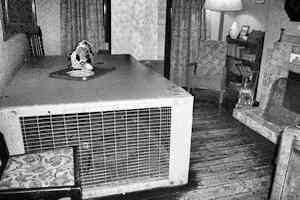 The
Anderson shelter consisted of pre-formed corrugated iron walls
and sides which were either buried or covered with earth in your
garden. By the end of 1940, millions had been distributed all
over the country. The
Anderson shelter consisted of pre-formed corrugated iron walls
and sides which were either buried or covered with earth in your
garden. By the end of 1940, millions had been distributed all
over the country.
The shelters were free if you earned less than £250
a year, but you had to pay a £7 charge if you were on a
higher income. The rusting remains of Anderson shelters can still
be found in some local gardens.
Named after Minister of Home Security Herbert Morrison,
the Morrison shelter (left) was introduced in 1941 and supplied
on a similar cost basis to the Anderson. It was essentially a
bombproof steel mesh cage which a small family could just about
sleep inside. Normally erected in the living room, it doubled
as a table. They took up a lot of room, but Morrison shelters
were only officially allowed to be removed in 1945.
Communal Air Raid shelters
Public shelters were constructed for people who
did not have their own shelter, or were in transit at the time
of the alert.
|
Air Raid Shelters in the Charminster
area (February 1942)
|
| Location |
Type |
Accommodation |
Classification |
Bunks |
| Fiveways Hotel, Charminster |
B |
50 |
|
9 |
| Cemetery Junction |
S |
200 |
|
0 |
| 21 - 23 Charminster Road |
B |
167 |
|
24 |
| 280-288 Charminster Road |
B |
200 |
Dormitory and Canteen |
36 |
| Winton Recreation Ground |
S |
150 |
|
0 |
|
B = Basement Shelter GF
= Ground Floor Shelter S = Surface Shelter
|
Rest Centres
After a raid, a number of people could be expected
to have had their homes either destroyed or rendered temporarily
uninhabitable. This could be simply because of a ruptured gas
or water main in a nearby road. To help these people, "Rest
Centres" were established. The ones serving the Winton population
were at :
| Lowther Road School |
St Albans Church House, Charminster |
Charminster Senior School, East
Way |
| Porchester Road School |
Bournemouth School for Boys, East
Way |
Stokewood Road Baths |
| Malmesbury Park Junior and Infants
School, Shelbourne Road |
Auxiliary Rest Centres were at:
Charminster Road Congregational
Church Hall
|
Gymnasium, 516 Charminster Road |
| Winton Recreation Ground Bowls
Pavilion |
St Augustines, Nortoft Road |
| St Francis of Assisi Church Hall, Charminster
Road |
St Andrews Church Hall |
These were the official instructions issued to bombing victims
in 1942:
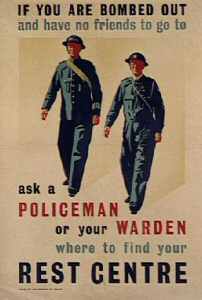 If
you have been rendered homeless, and you are not able to go
to friends or relatives or make other arrangements, you should
go to the nearest Rest Centre or Auxiliary Rest Centre. The
Air Raid Wardens and Police will direct you if you are in doubt
where to go. If
you have been rendered homeless, and you are not able to go
to friends or relatives or make other arrangements, you should
go to the nearest Rest Centre or Auxiliary Rest Centre. The
Air Raid Wardens and Police will direct you if you are in doubt
where to go.- Rest Centres and Auxiliary Rest Centres in any locality where
an incident takes place will be opened. If the raid should be
a heavy and sustained one all Rest Centres and Auxiliary Rest
Centres will be opened.
- At Rest Centres and Auxiliary Rest Centres you will be able
to shelter and rest until other arrangements can be made.
- At Rest Centres sleeping accommodation and food will be provided.
- At Auxiliary Rest Centres hot drinks will be provided, but
not sleeping accommodation or food.
- Clothing: Supplies of emergency clothing will be available
at Rest Centres and Auxiliary Rest Centres.
- 48-hour billets: Representatives of the Women's Voluntary
Services will attend at the Rest Centres and Auxiliary Rest
Centres which may be opened with lists of billets to which homeless
persons may go for a short period (not exceeding 48 hours).
Homeless persons who may be willing to go to such billets will
be conducted or taken there by the Women's Voluntary Services
representatives.
- Official Billeting: Official billeting officers will
attend at the Rest Centres which may be opened (but not at the
Auxiliary Rest Centres) to billet homeless persons for whom
such accommodation may be required. The payment of billeting
allowances is intended to be a temporary measure operating only
until the homeless persons are able either to return home, or
to obtain accommodation of their own or to make their own financial
arrangements with their hosts. Except in the cases of persons
who are in receipt of an allowance from the Assistance Board
or Supplementary Pension, Billeting Notices will in the first
place be issued for a period not exceeding two weeks. The question
whether a billeting notice should be reissued after this period
will be for the billeting authority to decide according to the
circumstances.
- Information: Information Officers will attend at the
Rest Centres and Auxiliary Rest Centres which may be opened
to give information and advice.
- Travel Vouchers: If you can make arrangements to go
and stay with friends or relatives you will be given a free
travel voucher if you cannot get to them without help. Enquire
about this at the Rest Centre of Auxiliary Rest Centre to which
you may go.
- Have your plans ready. If you have not already done
so, you should try to make plans now to go and stay with friends
or relations in case your house is destroyed. They should also
arrange to come to you if their house is destroyed. The usual
billeting allowances will be payable in such cases.
Rationing and food
Most forms of food were rationed by the middle of
1941 and it became an increasing problem to cook meals with any
variety.
Meals eaten at restaurants or industrial canteens,
on the other hand, did not require the use of any precious ration
coupons. This in part led to the popularity of self-service "British
Restaurants" run by local authorities as a means of preparing
good but cheap meals for a large number of people.
Bournemouth's first British Restaurant was in Winton.
It was opened in August 1941 in the repaired former Girls School
building in Alma Road.
You could buy a three course meal for less than
a shilling (5p) and it rapidly became very popular. Originally
seating 200, it ended up serving around 500 lunches a day.
Run-up to D-Day
Thousands of troops were stationed in and around
Bournemouth in the final preparations for the Normandy landings.
Military vehicles took advantage of the cover provided by tree-lined
avenues. They were parked head to tail around Queens Park where
American troops were temporarily camped.
|